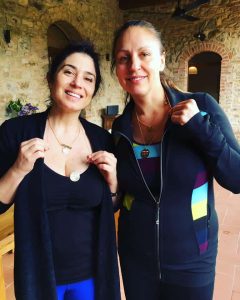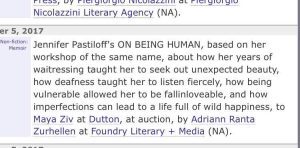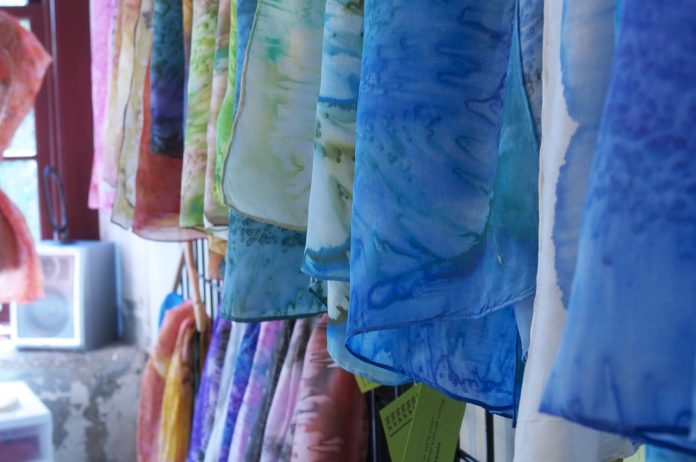At first the jewelry takes me by surprise: chandelier earrings, layered necklaces, sequined infinity scarves that have no business in a room where store-brand cans of pineapple and orange juice are the only drinks served. A big show is made of giving these things ample space on tiny end tables alongside Dixie cups of Tylenol. Companions are ordered to remember these silver hooks and spirals once the session ends, and in the meantime, to keep an eye on the table should the items’ owners need to use the toilet. Simply standing up while making sure to lift the arm so that the wrist retains the IV and the IV stays attached to the machine that must be wheeled into the bathroom while managing the door lock with the free hand, all while the first dizzy spell begins (no, thank you, I can manage) is such an all-consuming task that asking after your Alex and Ani bangles set in that moment is out of the question.
I used to wonder why they won’t leave these things at home, but now I know why all of it must be worn, even if only in the lobby. I recognize the sigh from the woman two seats down as she uncoils ropes of translucent orange beads from her neck: it matches my tone when telling the scheduling coordinator to hold as I shake out receipts and crumbs and broken pens from three different purses when I could just as easily store the Medical Record Number card in my wallet with my driver’s license and the other items anchoring my everyday. Now I understand that “fighting cancer” does not mean doing certain tasks with gusto but refusing to grant others the time and care they’re supposed to deserve.
As for me, I wear my great-grandmother’s rose gold chain, its sharp rectangles falling just below my collarbone and exactly where a chest port would be if I needed one. My grandmother’s accompanying note reads “I want you to wear her things. NOW!” and I honor her demand. Wearing this chain, I grasp the concept of a “statement” necklace: this piece states that I’m not here long enough for a chest port, this searing jab to my wrist is truly a perk of this good-kind lymphoma, and the nurse is visibly annoyed at the extra work so my demeanor had better be accomodating since my small veins are not.
I study the clothing of the other women with paper bracelets just as carefully as I’d noted the outfits of the varsity girls on the first day of high school track practice. My oncologist awaits my questions, but I can’t ask “What do I wear for chemo?” any more than I could have asked my track coach whether Grateful Dead Bears would remain the preferred tee-shirt design for next season or fade out with the graduating seniors. Yet in both cases, I know that getting it wrong would mark me as the kind of girl no one wants to be or be seen with.
No, I won’t ask my oncologist what to wear. This is a space for serious queries: fertility prospects, survival rates, side effects from the mildly annoying to the downright lethal. Still, it’s tempting to ask as I notice purple Doc Martens peeking out from her black trousers. Those are not the shoes of someone who does not take shoes seriously.
****
Although the air conditioning is cranked high enough to warrant a heated blanket for every patient–two if your wrist must be wrapped to coax out a vein–sandals are the footwear of choice. Those who can will coordinate their sandals and jewelry: gold and silver fringe dangling from glamorous gladiator straps. Those who must pay more attention to how (if) they can walk without aid wear sensible shoes that tie: not too bulky and with some sleek pastel striping if possible. As for the most advanced, thin as in skinny and not as in svelte, those who pair things like Chicago Bulls knit caps with Frozen t-shirts and flared jeans frayed at the hems, they wear the worst kind of shoes: synthetic leather with Velcro straps, the kind that do nothing to you or for you, that are put on rather than picked out.
I wear rubber flip-flops that are pricey and popular. $30 flip-flops are a ludicrous purchase any day, especially now when they cost twice as much as both of my anti-nausea prescriptions combined, but I must have them. I must stand out as royalty in the kingdom of the not-quite-well, to anyone who asks how I feel, have I fallen, am I tired; flip-flops are the footwear for those who can most afford to take their feet for granted. I already own four pairs and like any luxury item, more is always and never enough. In a few hours when the fever sets in and my brain leaps miles ahead of my body, I’ll squander the last of the day’s energy scouring Amazon for new colors. The black ones are just for chemo days. Perfect for errands, being here and getting out.
Fortunately, we’re in the peak of the yoga pants craze so I can tell myself that the elastic band is purely for convenience, not necessity. I could still manage a button fly with one wrist and an IV drip in the other if I had to.
My tote holds a new paperback of 100 Years of Solitude and my social worker likes to rhapsodize about how the chemo floor’s roof-garden view offers “a relaxing place to read.” Someday, I’ll get the one station that overlooks the rooftop garden and not the trash-strewn parking lot. And then perhaps this view will inspire me to stay awake for Marquez instead of dozing off to an article about Keira Knightley’s favorite eyeliner from a back issue of Allure.
As I would for any errand lasting more than three hours, I bring snacks: Cheerios, nuts, a Luna Bar if my gut feels ambitious. When the nurse arrives, I’ve already set the table: a little empty space for the Dixie cup of Tylenol to my left, a water bottle and a Ziploc baggie of almonds to my right.
I want whoever walks by to know I’m the kind of girl who travels with almonds in baggies. Raw almonds, responsible “snack size” baggies.
I want them to know it’s not my fault I ended up here.
****
Once I can get out of bed again, my outfits are a different story entirely. It now takes at least an hour to get dressed. Hair loss triples my options and raises the stakes exponentially. What I place on my head determines the type and substance of human interaction I can expect from the moment I step outside. Wig for anonymous, prolonged immersion among strangers indoors, baseball cap for outdoor errands and chance meetings with acquaintances to be ended quickly. Scarves for only the closest of friends. Not all of my skirts go with headscarves and my baseball caps don’t go with the same shirts as my wig does. I may have to try three, four different combinations before I can almost convince my reflection that this is all by choice.
I look forward to my first day in a scarf with anxious excitement. I revive a habit lost since grade school and drape my clothes carefully over my desk chair the night before. I choose a short khaki skirt in olive green, pleased that my long legs remain free of the scars that shadow the crooks of my elbows and the tops of my wrists. (My veins are “difficult,” so I’m told.) An orange tank top with tiny elastic ruffles at the shoulders. Silver hoop earrings, my signature flip-flops in brown. And the scarf: navy with bursts of orange elephants and pink paisley swirls, bought years ago for autumn work outfits and not a special purchase for this unexpected summer.
The next morning, for the first time in weeks, I apply makeup: brown eyeliner and a tinted lip balm, realizing regretfully that I’ll have to throw out anything I use while on chemo and Hibiscus is always the first Burt’s Bees lip shade to sell out. My hair still has some strands that, when placed to poke out of the scarf, look like bangs one gets on purpose. It looks just right and it is alright as I pay for my stamps at the post office and am treated with the same surly indifference as any other customer in line. I feel triumphant. After years of pondering before fitting room mirrors if I could “get away with” certain apparel, I’ve finally gotten away with something big–much bigger than a string bikini or a crop top.
But my victory is short-lived. I’ve barely made it across the parking lot when a woman
rolls down her window to exclaim: “I just have to tell you that I love your scarf!”
I thank her, but I’m confused: should I feel ashamed or appreciated? Someone noticed, and isn’t that the point? But someone noticed.
Do I look worth noticing?
Do I look sick?
Nevertheless, a crowded post-office is not an unpleasant place to be. While scarves are no longer a safe bet, a cap will do if it’s too hot for the wig: no one ever comments on women’s baseball caps outside of stadium parks. Besides, mine bears only the logo from my father’s workplace several states away, no familiar mascot to spark small talk that could lead to bigger talk if the line is long enough. Soon I start creating reasons to take the well-shaded walk there and back on good days. I order an iPod adapter that I suspect won’t fit my ancient model, write checks for bills more easily paid online.
Here at the post office, I’m guaranteed just the right mix of acknowledgment and anonymity to feel both ordinary and sheltered. The drugstore comes in a close second, but even that is a risk: too many aisles I can’t scan quickly, too many chances for running into an almost-friend who wants to tell me about her cousin’s boyfriend’s step-sister who died of cancer but hers was way worse and she didn’t look as great as I do and by the way I really do look
amazing. And in the post office, nothing is forbidden: packing tape, Peanuts greeting cards, bubble wrap, whatever I want I can have. At Walgreens, sometimes a strip of cardboard wrapped in hair ties ends up in the cart, and then I catch myself at the checkout, remembering that there are some parts of life to which I no longer belong, feeling chastised by something I can neither name nor see, as if I’d attempted to purchase a country club membership and was denied for being off in some crucial yet unmentionable way.
****
My infusion is at a later time today, and there is someone new in the station next to mine. Hers is a style I haven’t yet seen. She wears a billowy hybrid of a dress and a nightgown, in a yellow made from fading or soil or bleach but definitely not on purpose. Her hair is real, I’m sure. No short wig could look that aggressively unkempt, too blonde for gray and too brown for clean, a man’s toupee in a prime-time sitcom that stages the joke two commercials before the punchline.
I can’t see her face from where I’m sitting.
I feel a sentence form: She makes no effort. I know where it comes from but wish I didn’t: it’s a frequent line in the comment boxes beneath red carpet photos of actresses who did not “get away with” their dresses. I haven’t said a word, not even a side-eyed whisper to my fiancé, but I’m embarrassed nonetheless, certain that everyone can smell the thought leaking from my pores. She makes no effort. Effort is always intransitive in these cases, its object both invisible and universally understood.
And her tables! She’s crowding up two of them with Styrofoam takeout containers, their open lids drooping lazily off the edge. I smell grease, something fried. Finished with this meal, she is telling her unseen companion about another, a roast beef sandwich that was terrible, just terrible, last week at a diner in Belen–a town I know in name only as the last stop on the New Mexico Railrunner. I start wondering if she lives in Belen. Does she have to catch a train after her sessions or does someone drive her? Can she sleep soundly in the car, assuming her fever lets her sleep without waking up anxious and clammy every 20 minutes?
But I can’t afford empathy. Compassion is not as potent a diversion as anger, and I need to stay alert, not give in to the soothing warmth of the electric blanket wrapped around my left forearm, not when I know why the blanket’s there and what’s coming. I shift from concerns about her literal journey to our shared metaphorical one, the “cancer journey.” If the brochures insist on this tired metaphor, then let’s ride it all the way. These pleather La-Z-Boy contraptions are first-class plane seats and I’m allowed to be as annoyed with her as I would be with any other passenger who breaks the rules.
My assigned nurse for the afternoon arrives. “Looks good,” she says after unwrapping the blanket, even though to me my arm looks exactly the same as it did ten minutes ago. Her black hair is swept into a high ponytail with a slight bouffant, the kind of updo that shows just as much care for its own display as for workday practicality. (I add “bouffant pony” to my growing list of updos to try once my hair grows back, even though I used to scoff endlessly at women who sported them.) Her Barbie pink nails, perky lashes, and impeccably lined lips make her look more like a hairdresser than a nurse; she even leans in for some hairdresser gossip. “Wow,” she whispers, jerking her head toward Belen sandwich lady’s station, “She’s loud, huh?” I’m more grateful for this small kindness than for all the toothy grins and felt-wrapped flower pens of the check-in receptionists. For those precious seconds as she puts on latex gloves and removes the needle from its sterilized packaging, we are not nurse and patient, but stylist and client. It works so well that when she does take a half-second longer than she should to find the vein, I apologize for swearing and she apologizes for hurting me. “I’m sorry that I hurt you,” she says, as if the pain were from an accident no less offensive and unnecessary than if she’d stepped on my toe in a subway car.
When the nurse wakes me, the woman is gone as are most of the other patients. “Would you like a wheelchair for the way out?”, she asks, no longer using a voice that suggests we’re peers.
“No,” I lie, trying not to lean too obviously against the wall while I wait for my fiancé to bring the car around. Best to leave the lobby benches for those who really need them.
On the drive home, my fiancé tells me what I missed: “Sounds like she’s had a hard life, kind of a Tennessee Williams character. Her kids were taken away.”
Tennessee Williams…We round the corner where the medical complex ends and the main drag begins and as we pass the blinding glitz of the hookah lounge’s spinning sign and then the McDonald’s arches, I hunt for an image that might let me stay with him. But my eyes are closing several blocks before the turn for our street and I see only my 12th grade English textbook open to the first pages of The Glass Menagerie, the font blurred except for the title in bold black script. There is a grainy photo of a female figure in side profile. She is wearing what would be a dress on a young girl, a nightgown on a woman. Her red hair is pulled up in a messy bun that would look convincingly chic if the white gown were more convincing period. Holding a small white object at the end of outstretched arms, it’s impossible to tell if she’s just accepted something handed to her, or if she’s reaching, hoping the actor who remains out of focus will accept whatever she has to offer.
***


